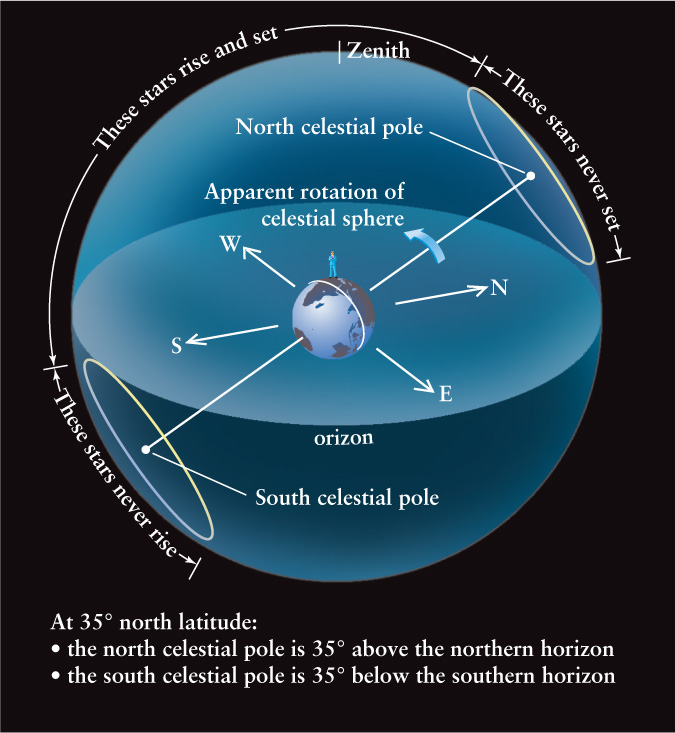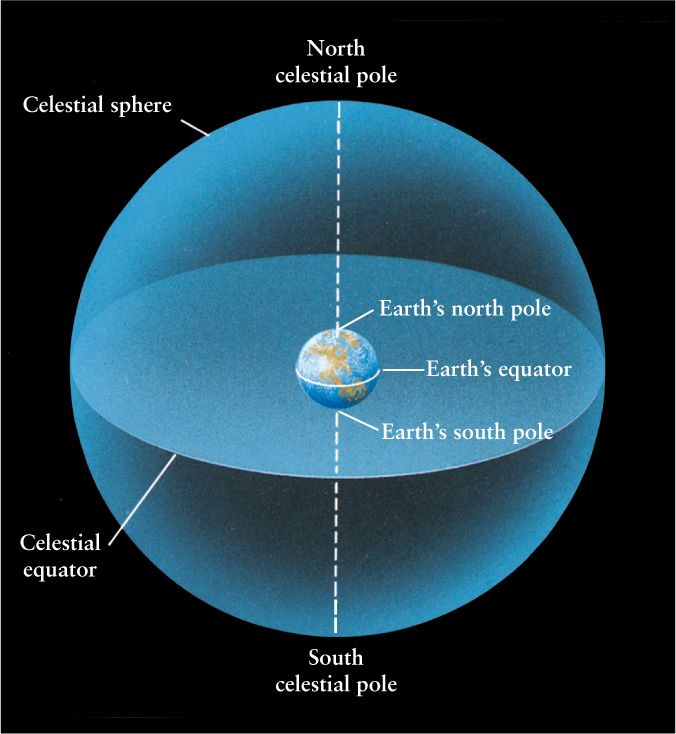2-4 It is convenient to imagine that the stars are located on a celestial sphere
 Many ancient societies believed that all the stars are the same distance from Earth. They imagined the stars to be bits of fire imbedded in the inner surface of an immense hollow sphere, called the celestial sphere, with Earth at its center. In this picture of the universe, Earth was fixed and did not rotate. Instead, the entire celestial sphere rotated once a day around Earth from east to west, thereby causing the diurnal motion of the sky. The picture of a rotating celestial sphere fit well with naked-eye observations, and for its time was a useful model of how the universe works. (We discussed the role of models in science in Section 1-1).
Many ancient societies believed that all the stars are the same distance from Earth. They imagined the stars to be bits of fire imbedded in the inner surface of an immense hollow sphere, called the celestial sphere, with Earth at its center. In this picture of the universe, Earth was fixed and did not rotate. Instead, the entire celestial sphere rotated once a day around Earth from east to west, thereby causing the diurnal motion of the sky. The picture of a rotating celestial sphere fit well with naked-eye observations, and for its time was a useful model of how the universe works. (We discussed the role of models in science in Section 1-1).
The concept of the imaginary celestial sphere helps us visualize the motions of stars in the sky
Today’s astronomers know that this simple model of the universe is not correct. Diurnal motion is due to the rotation of Earth, not the rest of the universe. Furthermore, as we learned when discussing the constellations in Section 2-2, the stars are not all at the same distance from Earth. Indeed, the stars that you can see with the naked eye range from 4.2 to more than 1000 light-years away, and telescopes allow us to see objects at distances of billions of light-years.
Thus, astronomers now recognize that the celestial sphere is an imaginary object that has no basis in physical reality. Nonetheless, the celestial sphere model remains a useful tool of positional astronomy. If we imagine, as did the ancients, that Earth is stationary and that the celestial sphere rotates around us, it is relatively easy to specify the directions to different objects in the sky and to visualize the motions of these objects. Figure 2-9 depicts the celestial sphere, with Earth at its center. (A truly proportional drawing would show the celestial sphere as being millions of times larger than Earth.) We picture the stars as points of light that are fixed on the inner surface of the celestial sphere.
Other features on the celestial sphere result from projections. The projection of a point on Earth is made by extending an imaginary line perpendicular to the surface of Earth until it intersects the celestial sphere. If we project Earth’s north and south poles into space, we obtain the north celestial pole and the south celestial pole. Thus, the two celestial poles are where Earth’s axis of rotation intersects the celestial sphere (see Figure 2-9). The star Polaris is less than 1° away from the north celestial pole, which is why it is called the North Star or the Pole Star. If we project Earth’s equator out into space, we obtain the celestial equator. The celestial equator divides the sky into northern and southern hemispheres, just as Earth’s equator divides Earth into two hemispheres.


 The Celestial Sphere The celestial sphere is the apparent sphere of the sky. The view in this figure is from the outside of this (wholly imaginary) sphere. Earth is at the center of the celestial sphere, so our view is always of the inside of the sphere. The celestial equator and poles are the projections of Earth’s equator and axis of rotation out into space. The celestial poles are therefore located directly over Earth’s poles.
The Celestial Sphere The celestial sphere is the apparent sphere of the sky. The view in this figure is from the outside of this (wholly imaginary) sphere. Earth is at the center of the celestial sphere, so our view is always of the inside of the sphere. The celestial equator and poles are the projections of Earth’s equator and axis of rotation out into space. The celestial poles are therefore located directly over Earth’s poles.
The point in the sky directly overhead an observer anywhere on Earth is called that observer’s zenith. The zenith and celestial sphere are shown in Figure 2-10 for an observer located at 35° north latitude (that is, at a location on Earth’s surface 35° north of the equator). The zenith is shown at the top of Figure 2-10, so Earth and the celestial sphere appear “tipped” compared to Figure 2-9. At any time, an observer can see only half of the celestial sphere; the other half is below the horizon, hidden by the body of Earth. The hidden half of the celestial sphere is darkly shaded in Figure 2-10.
Motions of the Celestial Sphere
For an observer anywhere in the northern hemisphere, including the observer in Figure 2-10, the north celestial pole is always above the horizon. As Earth turns from west to east, it appears to the observer that the celestial sphere turns from east to west. Stars sufficiently near the north celestial pole revolve around the pole, never rising or setting. Such stars are called circumpolar. For example, as seen from North America or Europe, Polaris is a circumpolar star and can be seen at any time of night on any night of the year. The photograph that opens this chapter shows the circular trails of stars around the north celestial pole as seen from Hawaii (at 20° north latitude). Stars near the south celestial pole revolve around that pole but always remain below the horizon of an observer in the northern hemisphere. Hence, these stars can never be seen by the observer in Figure 2-10. Stars between those two limits rise in the east and set in the west.
CAUTION!
Keep in mind that which stars are circumpolar, which stars never rise, and which stars rise and set depends on the latitude from which you view the heavens. As an example, for an observer at 35° south latitude (roughly the latitude of Sydney, Cape Town, and Buenos Aires), the roles of the north and south celestial poles are the opposite of those shown in Figure 2-10: Objects close to the south celestial pole are circumpolar, that is, they revolve around that pole and never rise or set. For an observer in the southern hemisphere, stars close to the north celestial pole are always below the horizon and can never be seen. Hence, astronomers in Australia, South Africa, and Argentina never see the North Star but are able to see other stars that are forever hidden from North American or European observers.
For observers at most locations on Earth, stars rise in the east and set in the west at an angle to the horizon. To see why this is so, notice that the rotation of the celestial sphere carries stars across the sky in paths that are parallel to the celestial equator (Figure 2-11).

 The Apparent Motion of Stars at Different Latitudes As Earth rotates, stars appear to rotate around us along paths that are parallel to the celestial equator. (a) As shown in this long time exposure, at most locations on Earth the rising and setting motions are at an angle to the horizon that depends on the latitude. (b) At the north pole (latitude 90° north) the stars appear to move parallel to the horizon. (c) At the equator (latitude 0°) the stars rise and set along vertical paths.
The Apparent Motion of Stars at Different Latitudes As Earth rotates, stars appear to rotate around us along paths that are parallel to the celestial equator. (a) As shown in this long time exposure, at most locations on Earth the rising and setting motions are at an angle to the horizon that depends on the latitude. (b) At the north pole (latitude 90° north) the stars appear to move parallel to the horizon. (c) At the equator (latitude 0°) the stars rise and set along vertical paths.
CONCEPT CHECK 2-4
Where would you need to be standing on Earth for the celestial equator to pass through your zenith?
The celestial equator is a projection, or an extension, of Earth’s equator out into the sky. In order for this imaginary line to pass directly overhead, one would need to be standing somewhere on Earth’s equator.
How do we describe the location of a star? Using the celestial equator and poles, we can define a coordinate system based on angles to specify the position of any star on the celestial sphere. As Box 2-1 describes, the most commonly used coordinate system uses two angles, right ascension and declination, that are analogous to longitude and latitude on Earth. These coordinates tell us in what direction we should look to see the star. To locate the star’s true position in three-dimensional space, we must also know the distance to the star.